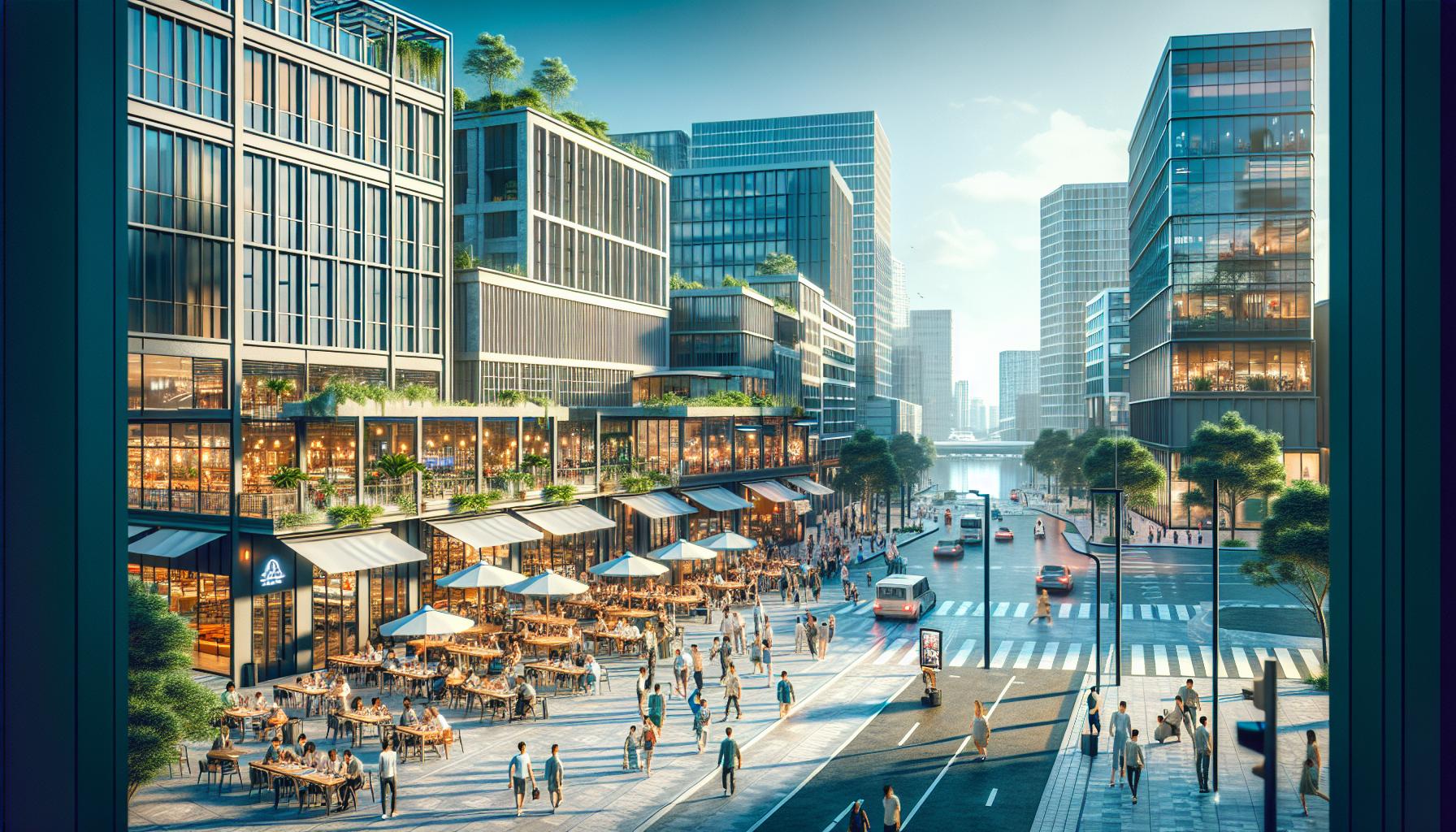I’ve always been fascinated by how cities evolve, and Kirkland, Washington, is no exception. Once a sleepy waterfront town, it’s now a bustling hub of innovation, brimming with energy and potential.
In the past decade, Kirkland’s transformation has been nothing short of spectacular. From the influx of tech companies to the burgeoning food scene, it’s become a magnet for those seeking a dynamic, forward-thinking community.
Join me as I delve into the fascinating story of Kirkland’s rapid growth and how it’s reshaping the city’s identity, culture, and future.
Kirkland’s Growth Spurt: A Journey
Let’s delve into Kirkland’s transformation. We examine its past and spotlight key milestones that marked its dynamic shift.
Examining Kirkland in the Past
Just a decade ago, Kirkland was a serene waterfront hamlet in Washington. Its landscapes were lush and unspoiled, and life here was quiet and unhurried. A typical Kirkland day revolved around fishing boats gliding across the serene lake and people ambling along its quaint cobblestone streets, relishing the simple pleasures life offered.
Indeed, once upon a time, it’s hard to envision that the bustling lanes of Kirkland were once a hub for shipbuilding and wool milling industries during the early days of Washington’s European settlement. Yes, the roots of Kirkland dig deep into the Industrial Revolution, demonstrating a tapestry of history and heritage.
Noteworthy Milestones in Kirkland’s Growth
Kirkland’s quietude began to change around 2010, as a wave of tech companies made their foray into the city. Undoubtedly, Google’s decision to set up one of its primary offices in Kirkland was a pivotal event. This move, occurring in 2004, played a substantial role in ushering an era of change.
The burgeoning list of tech companies further swelled with the entry of prominent players like GoDaddy and Tableau, strengthening Kirkland’s reputation as an innovation hub. It’s also worth noting the 2017 launch of the Village at Totem Lake, a transformative commercial project that bolstered the city’s economy significantly.
Today, Kirkland stands as an epitome of growth and urban innovation, a far cry from its past; it’s an intriguing amalgamation of vibrancy, tech innovation, and enhanced lifestyle, demonstrating a city unafraid to embrace challenges and transform with time.
Understanding the Transformation
Delving deeper, let’s explore the intricate factors contributing to Kirkland’s magnificent metamorphosis.
Infrastructure Contributions to City Development
Bridging the gap between past and future, Kirkland’s infrastructure played a pivotal role in its transformation. The city’s self-driven projects, such as the progressive redesign of public spaces, proved essential. Increased accessibility and traffickability were highlighted when the Cross Kirkland Corridor, a ten-foot-wide trail spanning 5.75 miles, became a reality. This project, completed in 2015, provided an example of the city’s commitment to enhancing the lives of its residents.
Another key infrastructure revitalization was the opening of Kirkland Urban, a mixed-use complex in 2019. This new development offered a blend of retail, office, and residential spaces in the heart of downtown Kirkland, fostering a greater sense of community.
Importance of Economic Factors
While infrastructure paves the way, it’s the economic fuel that powers a city’s growth engine. Kirkland’s surge can be attributed to a thriving local economy, driven by a diverse range of sectors. Tech harbored a leading role, with Google’s arrival in 2004 setting a precedent. Other tech giants followed, bolstering the city’s recognition as a tech hub.
Yet, it wasn’t just high-tech that fueled Kirkland’s economic growth. The city’s burgeoning food scene, marked by a flurry of new restaurants and craft breweries, weaved gastronomic magic. This culinary boom was evident in the packed tables at the iconic Flatstick Pub or the buzzing Marina Park during the Kirkland Uncorked event, a testament to a flourishing local economy enriched by distinct yet harmonious sectors.
Impact on the Inhabitants
This part of the article investigates the transformation’s effects on Kirkland’s residents. The conversation carries over into two primary aspects: changes in quality of life and population increase alongside the implications for the housing market.
Changes in Quality of Life
Kirkland’s metamorphosis from a tranquil waterfront enclave into a bustling hub of innovation resulted in noticeable shifts in residents’ quality of life. The city’s intensifying economic activities contributed to increased job opportunities, particularly in tech disciplines and the revitalized food scene. The implementation of infrastructural projects improved mobility and access, fostering increased community engagement around places like the Cross Kirkland Corridor, and the mixed-use complex, Kirkland Urban.
The infusion of culture, brought about by new restaurants and craft breweries, injected vibrancy into daily life. However, these shifts weren’t without challenges. An increased cost of living came hand-in-hand with Kirkland’s growth, forcing adjustments among the inhabitants. For instance, increased rents and property prices necessitated higher incomes or altered lifestyle choices.
Population Increase and the Housing Market
Kirkland’s rapid metamorphosis acted as a magnet, attracting people from across the nation to its newfound vibrancy. This influx, amplified by Google’s establishment and the city’s appealing food scene, led to a significant rise in population numbers over the past decade.
This population swell put considerable pressure on the housing market. Demand for housing surged, driving property prices higher. The city’s median home price leaped considerably compared to prices a decade ago. On the other hand, rental costs also saw substantial increases during this period. Consequently, the housing crunch intensified, creating a growing divide between homeowners and renters in Kirkland’s landscape. Bridging this gap presents a challenge for authorities as they balance continued growth with maintaining the city’s unique character and livability.
Pioneering Project Initiatives
In the wake of Kirkland’s transformation, several pioneering initiatives sprung up, effectively driving the city’s economic and infrastructural growth. Notably, the development projects enhanced the city’s landscape, accommodating the rapidly growing population and business sector.
Major Development Initiatives
Several key initiatives have provided an infrastructural backbone to Kirkland’s development. The Village at Totem Lake, a multi-million dollar project completed in 2017, revamped the old shopping center into a mixed-use lifestyle center, integrating retail spaces with residential homes. Kirkland Urban, another mixed-use complex launched in 2019, bolstered the city’s commercial appeal offering retail outlets, offices, and apartments.
The Cross Kirkland Corridor, an old railway line transformed into a pedestrian and cycle trail in 2015, is another prime example. This unique project connected neighborhoods, promoted healthy living, and fostered a stronger community spirit. Meanwhile, Google’s expansion in 2004 played a vital infrastructural role, drawing a multitude of tech companies and reinforcing Kirkland’s identity as a tech hub.
These initiatives exemplify the city’s capacity for innovative urban planning. Their success lies in the seamless fusion of commercial viability with community interests, setting a precedent for future urban development projects.
Comparative Study
In today’s rapidly evolving world, cities like Kirkland are no exception. Let’s look at the city’s evolution, touching base with its past and acknowledging its present growth.
Kirkland Today vs. Yesterday
Comparing the Kirkland of yesteryears to its present version reveals dramatic changes. The city once graced with tranquil waterfront views and simple small-town charm has metamorphosed into a bustling hub. Earlier, the lifestyle was more leisurely, and the city’s pace reflected its serene setting.
Fast forward to the current time, Kirkland has transformed into a dynamic city with towering commercial buildings like Kirkland Urban, humming with activity, blending in perfectly with the modern cityscape. The tech sector’s stronghold, especially Google’s establishment, has disrupted the once quiet town’s rhythm and introduced a quicker, more cosmopolitan tempo.
Furthermore, the food and beverage scene is another significant change. Previously, fewer culinary options existed, but with the economic growth, an explosion of new restaurants and craft breweries emerged. This cultural shift has added a new vibrational frequency to Kirkland’s identity, enriching the city’s evolving character.
However, progress always brings challenges. The expanding population and increased housing demand have surged property prices, creating a wedge between homeowners and renters. This price increase is a double-edged sword, reflecting growth but also raising affordability concerns.
Summing up, the Kirkland of yesterday and today stand as stark contrasts — one a placid waterfront town, the other a bustling city. It’s a journey of transformation that continues to shape Kirkland, ensuring it remains a relevant city in today’s urban development dialogues.
Drawbacks of Rapid Urbanization
Despite its evident growth and vibrancy, Kirkland’s transformation has not come without challenges. Rapid urbanization has led to certain adverse effects, that bear reckoning.
Growing Pains: Traffic and Congestion
One of the foremost impacts of Kirkland’s swift expansion is increased traffic and congestion. As more businesses set up shop and the population surges, the city’s roads see far higher use. Google’s establishment, alongside the proliferation of other tech companies, attracted a influx of workers, leading to an added daily influx of vehicles on the city’s streets. Also, major commercial projects like the Village at Totem Lake and Kirkland Urban have drawn in considerable visitor traffic, escalating the congestion.
Environmental Concerns
In addition to traffic woes, rapid urbanization also heightens environmental concerns. In Kirkland’s context, developments and construction activities bear the potential to disrupt local ecosystems. For instance, revamping the old shopping center into the Village at Totem Lake required considerable restructuring and construction, likely affecting the surrounding natural habitats. Moreover, such rampant urban development can lead to increased pollution, due to a rise in emissions from additional vehicular traffic, or from operations of the commercial entities themselves. Ensuring sustainable growth, therefore, proves a crucial challenge for the city.
The Future of Kirkland
Moving forward, Kirkland sees a horizon full of promise and continued evolution. Given the dynamic changes observed in the prior decade, the future undeniably holds noteworthy transformations.
Planned Developments and City’s Vision
In line with the city’s continuing growth, several significant developments, planned for the foreseeable future, intend to amplify the diverse and energetic character of Kirkland. The core city vision focuses on ensuring a seamless balance between city expansion and maintaining the unique, small-town charm.
For example, developments like the Totem Lake Connector Bridge aim to enhance connectivity across the city, fostering continued business growth while promoting a friendly community atmosphere. Multiple mixed-use towers, specifically The Potala Village and West Main, bring more residential and commercial spaces, complementing Kirkland’s bustling economy and addressing the population surge.
In addition, the city plans to improve public transportation systems, mitigating traffic and congestion issues. New park projects, like the 132nd Square Park renovation, aim to preserve the city’s green spaces amidst urban expansion.
Overall, the city’s vision intertwines growth and livability, always striving to foster a sense of community and encouraging further business influx, while simultaneously preserving Kirkland’s unique, small-town ambiance. Together, planned developments and the city’s vision curate a future that values progress, inclusivity, and sustainable living.
Acknowledging the Growth Spurt: Perspectives
The growth spurt in Kirkland has elicited a variety of reactions from both residents and city officials. Their individual views provide insight into the city’s transformation.
Resident Views on the Transformation
Many residents express a mixed response towards Kirkland’s transformation. They acknowledge the city’s robust development, attributed mainly to booming tech companies and a burgeoning gastronomic scene. Examples include Google’s establishment in 2004 and the influx of new restaurants and craft breweries that have enlivened the local economy.
Residents feel the city’s economic activities have led to increased job opportunities and improved mobility, fostering community engagement. Yet, these benefits come with their own set of challenges. A rising cost of living has forced some residents to adjust their lifestyles.
Moreover, some residents voice their concern about the housing market. Kirkland’s appeal has attracted a significant population increase, subsequently driving up property prices and rental costs. This has created a growing dichotomy between homeowners and renters, a crucial issue for many residents.
Opinions of City Officials
City officials exhibit a positive outlook towards Kirkland’s transformation. They believe the city’s metamorphosis from a quiet waterfront town to a dynamic center of innovation has favorably positioned Kirkland in the region.
City officials view infrastructure as a pivotal element in the city’s development. Examples include the completion of the ten-foot-wide trail, the Cross Kirkland Corridor, in 2015, and the launch of Kirkland Urban, a mixed-use complex, in 2019.
Furthermore, city officials perceive the revamp of the Village at Totem Lake, an old shopping center transformed into a lifestyle center combining retail and residential spaces, as a successful implementation of a city development strategy.
However, they recognize the challenge of balancing the city’s growth with maintaining its character and livability, particularly in light of increased traffic congestion and environmental concerns. City officials emphasize the importance of sustainable growth and have plans for future developments that aim to enhance the city’s diverse character while preserving its small-town charm. These include projects like the Totem Lake Connector Bridge and new mixed-use towers, which project a promising future for Kirkland.
Conclusion
It’s been a wild ride watching Kirkland’s transformation. From a quaint waterfront town to a bustling hub of innovation, the city’s growth spurt is nothing short of remarkable. The arrival of tech giants like Google, coupled with significant commercial projects like the Village at Totem Lake and Kirkland Urban, have truly put Kirkland on the map. However, with growth comes challenges. Rising living costs and increased traffic are realities we’re grappling with.
Yet, Kirkland’s future looks promising. Planned developments like the Totem Lake Connector Bridge and new mixed-use towers are set to address population growth while preserving our small-town charm. It’s a delicate balance, but one that I believe our city is capable of achieving. As we move forward, let’s remember to celebrate our progress, learn from our challenges and continue to shape Kirkland into a city that’s not only economically thriving but also a wonderful place to call home.





0 Comments